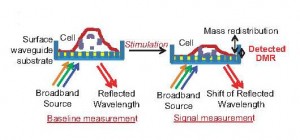Much of the time in biochemistry, when you want to know what’s happening inside a cell you have to break them open.
Fluorescent proteins are a great tool and deserved their Nobel Prize. But you have to convince your favorite cells to make the fluorescent proteins first. It’s possible to think of specialized non-invasive probes too: dyes that change color when they encounter calcium, for example.
Now imagine being able to decipher what’s going on inside cells simply by looking at them and watching the proteins and organelles shift in response to signals. That’s essentially what Yuhong Du and Haian Fu at the Emory Chemical Biology Discovery Center have been able to do.
They use an “optical biosensor” which puts cells in front of a reflective grating. Depending on how the grating reflects light, they can measure mass redistribution inside the cells.

How the optical biosensor works
With this technology, they could watch for responses as cancer cells responded to signals from EGFR (epidermal growth factor receptor).
Drugs such as gefitinib and erlotinib are supposed to block those growth signals in lung cancer cells, but not every cancer responds to them. These results suggest that the optical biosensor system could be used to screen for compounds that block EGFR and many other receptors, potentially speeding up the hunt for drugs against several diseases.

